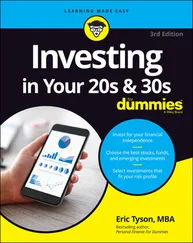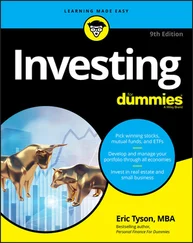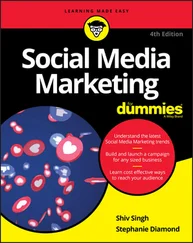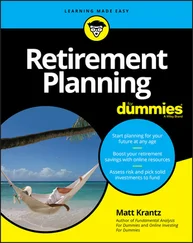Equity: If you’ve ever bought stock in a company, be it an individual firm like Microsoft or an index fund that invests in companies in the Standard & Poor’s (S&P) 500, you’ve been on the investor end of an equity deal. Investment bankers help companies raise money by selling ownership stakes, or equity, in the company to outside investors. After the securities are sold by the investment bank, the owners are free to buy or sell them on the stock market. Equity is first sold as part of an equity offering called an initial public offering (IPO).
Debt capital: Some investors have no interest in owning a piece of the company, but they’re more than willing to lend money to it, for a price. That’s the role of debt capital. Investment banks help companies borrow money by issuing bonds, or IOUs, that are sold to investors. The company must pay the prearranged rate of interest, but it doesn’t give up any ownership of the company. If a company falls onto hard times, though, the owners of the debt have a higher claim to assets than do the equity owners if a liquidation of the company is necessary.
Hybrid securities: Most of what investment banks sell can be classified as either debt or equity. But some securities take on traits of both, or are an interesting spin on both. One example is preferred shares, which give investors an income stream that’s higher than what’s paid on the regular equity. But preferred shares don’t come with as high a claim to assets as bonds, and this income stream can be suspended by the company if it chooses.
The services investment banks provide
Investment banks do much more than just raise capital by selling investments. Although selling securities to raise money is arguably the primary function of investment banks, they also serve several other roles. All the functions of investment banks typically fall into one of two primary categories: selling or buying.
The sell side: Investment banks are best known for the part of their business that sells securities, or the sell side. This function of the investment bank is responsible for finding investors to buy the securities being sold, which raises the money needed by businesses and governments to grow and prosper.
The buy side: Investment banks may also take the role of advising the large investors who are interested in buying financial instruments. Serving in its role on the buy side, the investment bank can offer suggestions to large institutional investors like mutual funds, pension plans, or endowments on which securities may be appropriate for it to buy in order to meet return targets.
 The dual role played by investment banking operations, serving both buyers and sellers of securities, raises constant worries of double dealing and conflicts of interest. Some people rightly question whether it’s possible for the same investment bank that makes money selling shares of an IPO, for instance, to give honest and unbiased investment advice to investors trying to decide whether they should buy or sell. The question of conflicts of interest in investment banking operations has become paramount since the financial crisis began in 2007.
The dual role played by investment banking operations, serving both buyers and sellers of securities, raises constant worries of double dealing and conflicts of interest. Some people rightly question whether it’s possible for the same investment bank that makes money selling shares of an IPO, for instance, to give honest and unbiased investment advice to investors trying to decide whether they should buy or sell. The question of conflicts of interest in investment banking operations has become paramount since the financial crisis began in 2007.
How investment banks are organized
Investment banks may seem like financial behemoths that have their hands in just about any matter that involves large sums of money. And to a large degree, that’s true. Investment banks are usually involved in some fashion when it comes to financing major projects, conducting trading in financial instruments, or developing new ways to generate capital.
With that said, nearly all major investment banks divide their operations into several key areas, including the front office, middle office, and back office. When you talk to someone about investment banking, or even listen to the heads of investment banks talk, they’ll often refer to these three common parts of a traditional investment bank:
The front office: The front office is exactly what it sounds like. It’s not only the part of the investment bank that sells investments, but also the part that courts companies looking to do deals. Traditionally, companies that are looking to find a fast way to turbo-charge growth may think about buying another company (say, a rival with similar customers or complementary technology).From the front office, investment banks help usher along the M&A process by pairing up buyers and sellers. The front office is also the part of the investment bank that conducts trading (frenetic buying and selling of securities to take advantage of any mispricings — even if the holding period is for only a few seconds). Investment banks used to do some trading using complicated mathematical formulas and using the firm’s money (not the clients’ money). This type of trading is often called proprietary trading. Many investment banks used to operate a business where they bought and sold securities themselves. Proprietary trading was quite profitable for investment banks. But most types of so-called prop trading by investment banks were abolished in mid-2015 by the Volcker Rule. The rule is named after former Federal Reserve Board Chairman Paul Volcker. Volcker said risky trading put large financial institutions at risk. Such trading was blamed in part for the financial crisis of 2008. Investment banks will continue to wind down this part of their businesses into the early 2020s. Another part of the front office is the part of the business involved in conducting research on companies. The front office often employs sell-side analysts, whose job it is to closely monitor companies and industries and produce reports used by large investors trying to decide whether to buy or sell particular securities. (You can find out more about research analysts in Chapter 2.)
The middle office: The middle office of an investment bank is generally out of the limelight. It’s the part of the bank with the job of cooking up new types of securities that can be sold to investors. Some innovations in investment banking are useful, but others can wind up putting investors and the markets in general in an unfavorable light. Some of the infamous financial instruments cooked up in the middle office of investment banks that came back to haunt the system include auction-rate securities and credit default swaps. Auction-rate securities are debt instruments that promise investors higher rates of return than are available in savings accounts. Instead of selling debt at a prearranged interest rate, the investment bank would conduct auctions, and the rate would be set by a bidding process. That’s great as long as there are willing buyers and sellers. But the auction-rate market relied on auctions, many of which weren’t successful during the financial crisis that erupted in 2007. Many investors holding the securities found they couldn’t sell them because the market had dried up, causing a huge headache for the investors and investment banks. Credit default swaps are tools that allow lenders to sell the risk that borrowers won’t be able to meet their obligations. Credit default swaps operate as a form of unregulated insurance policies. These instruments got so complicated, though, that they exacerbated the financial interdependencies between giant financial firms, worsening the financial crisis that erupted between 2007 and 2009.
The back office: The back office is the part of the investment bank that is far from the glamour of the front office. It’s primarily made up of the systems and procedures that allow investment bankers to gather the data they need to do their jobs well. The back office, for instance, maintains the computer systems used by investment bankers to gauge interest in certain securities and provides traders the ability to make short-term bets on market movements. The parts of investment banking considered more operational in nature tend to fall into the back office.
Читать дальше
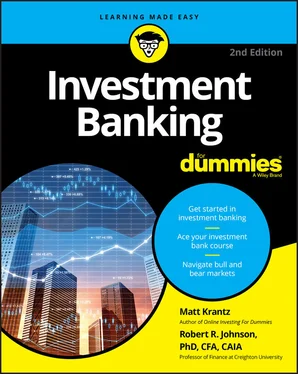
 The dual role played by investment banking operations, serving both buyers and sellers of securities, raises constant worries of double dealing and conflicts of interest. Some people rightly question whether it’s possible for the same investment bank that makes money selling shares of an IPO, for instance, to give honest and unbiased investment advice to investors trying to decide whether they should buy or sell. The question of conflicts of interest in investment banking operations has become paramount since the financial crisis began in 2007.
The dual role played by investment banking operations, serving both buyers and sellers of securities, raises constant worries of double dealing and conflicts of interest. Some people rightly question whether it’s possible for the same investment bank that makes money selling shares of an IPO, for instance, to give honest and unbiased investment advice to investors trying to decide whether they should buy or sell. The question of conflicts of interest in investment banking operations has become paramount since the financial crisis began in 2007.




